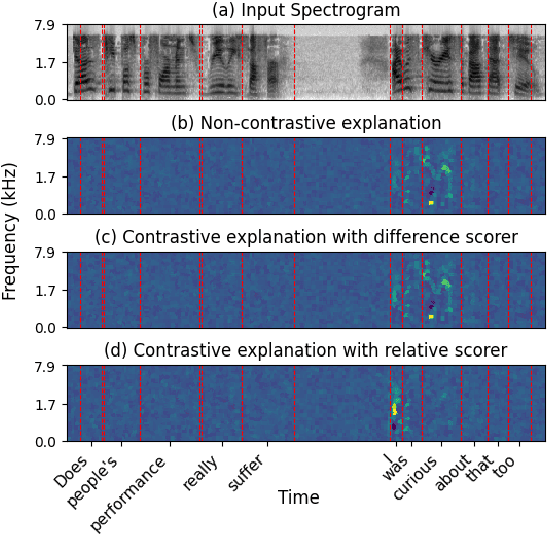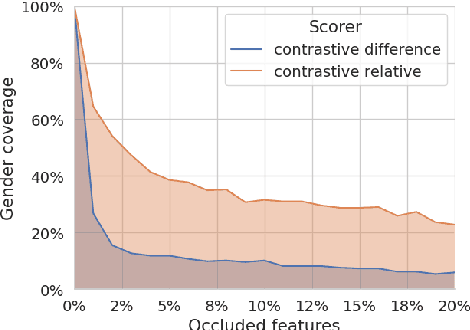Luisa Bentivogli
The Unheard Alternative: Contrastive Explanations for Speech-to-Text Models
Sep 30, 2025



Abstract:Contrastive explanations, which indicate why an AI system produced one output (the target) instead of another (the foil), are widely regarded in explainable AI as more informative and interpretable than standard explanations. However, obtaining such explanations for speech-to-text (S2T) generative models remains an open challenge. Drawing from feature attribution techniques, we propose the first method to obtain contrastive explanations in S2T by analyzing how parts of the input spectrogram influence the choice between alternative outputs. Through a case study on gender assignment in speech translation, we show that our method accurately identifies the audio features that drive the selection of one gender over another. By extending the scope of contrastive explanations to S2T, our work provides a foundation for better understanding S2T models.
An Interdisciplinary Approach to Human-Centered Machine Translation
Jun 16, 2025Abstract:Machine Translation (MT) tools are widely used today, often in contexts where professional translators are not present. Despite progress in MT technology, a gap persists between system development and real-world usage, particularly for non-expert users who may struggle to assess translation reliability. This paper advocates for a human-centered approach to MT, emphasizing the alignment of system design with diverse communicative goals and contexts of use. We survey the literature in Translation Studies and Human-Computer Interaction to recontextualize MT evaluation and design to address the diverse real-world scenarios in which MT is used today.
The Warmup Dilemma: How Learning Rate Strategies Impact Speech-to-Text Model Convergence
May 29, 2025Abstract:Training large-scale models presents challenges not only in terms of resource requirements but also in terms of their convergence. For this reason, the learning rate (LR) is often decreased when the size of a model is increased. Such a simple solution is not enough in the case of speech-to-text (S2T) trainings, where evolved and more complex variants of the Transformer architecture -- e.g., Conformer or Branchformer -- are used in light of their better performance. As a workaround, OWSM designed a double linear warmup of the LR, increasing it to a very small value in the first phase before updating it to a higher value in the second phase. While this solution worked well in practice, it was not compared with alternative solutions, nor was the impact on the final performance of different LR warmup schedules studied. This paper fills this gap, revealing that i) large-scale S2T trainings demand a sub-exponential LR warmup, and ii) a higher LR in the warmup phase accelerates initial convergence, but it does not boost final performance.
FAMA: The First Large-Scale Open-Science Speech Foundation Model for English and Italian
May 28, 2025Abstract:The development of speech foundation models (SFMs) like Whisper and SeamlessM4T has significantly advanced the field of speech processing. However, their closed nature--with inaccessible training data and code--poses major reproducibility and fair evaluation challenges. While other domains have made substantial progress toward open science by developing fully transparent models trained on open-source (OS) code and data, similar efforts in speech remain limited. To fill this gap, we introduce FAMA, the first family of open science SFMs for English and Italian, trained on 150k+ hours of OS speech data. Moreover, we present a new dataset containing 16k hours of cleaned and pseudo-labeled speech for both languages. Results show that FAMA achieves competitive performance compared to existing SFMs while being up to 8 times faster. All artifacts, including code, datasets, and models, are released under OS-compliant licenses, promoting openness in speech technology research.
An LLM-as-a-judge Approach for Scalable Gender-Neutral Translation Evaluation
Apr 16, 2025Abstract:Gender-neutral translation (GNT) aims to avoid expressing the gender of human referents when the source text lacks explicit cues about the gender of those referents. Evaluating GNT automatically is particularly challenging, with current solutions being limited to monolingual classifiers. Such solutions are not ideal because they do not factor in the source sentence and require dedicated data and fine-tuning to scale to new languages. In this work, we address such limitations by investigating the use of large language models (LLMs) as evaluators of GNT. Specifically, we explore two prompting approaches: one in which LLMs generate sentence-level assessments only, and another, akin to a chain-of-thought approach, where they first produce detailed phrase-level annotations before a sentence-level judgment. Through extensive experiments on multiple languages with five models, both open and proprietary, we show that LLMs can serve as evaluators of GNT. Moreover, we find that prompting for phrase-level annotations before sentence-level assessments consistently improves the accuracy of all models, providing a better and more scalable alternative to current solutions.
NUTSHELL: A Dataset for Abstract Generation from Scientific Talks
Feb 24, 2025Abstract:Scientific communication is receiving increasing attention in natural language processing, especially to help researches access, summarize, and generate content. One emerging application in this area is Speech-to-Abstract Generation (SAG), which aims to automatically generate abstracts from recorded scientific presentations. SAG enables researchers to efficiently engage with conference talks, but progress has been limited by a lack of large-scale datasets. To address this gap, we introduce NUTSHELL, a novel multimodal dataset of *ACL conference talks paired with their corresponding abstracts. We establish strong baselines for SAG and evaluate the quality of generated abstracts using both automatic metrics and human judgments. Our results highlight the challenges of SAG and demonstrate the benefits of training on NUTSHELL. By releasing NUTSHELL under an open license (CC-BY 4.0), we aim to advance research in SAG and foster the development of improved models and evaluation methods.
Translation in the Hands of Many:Centering Lay Users in Machine Translation Interactions
Feb 19, 2025Abstract:Converging societal and technical factors have transformed language technologies into user-facing applications employed across languages. Machine Translation (MT) has become a global tool, with cross-lingual services now also supported by dialogue systems powered by multilingual Large Language Models (LLMs). This accessibility has expanded MT's reach to a vast base of lay users, often with little to no expertise in the languages or the technology itself. Despite this, the understanding of MT consumed by this diverse group of users -- their needs, experiences, and interactions with these systems -- remains limited. This paper traces the shift in MT user profiles, focusing on non-expert users and how their engagement with these systems may change with LLMs. We identify three key factors -- usability, trust, and literacy -- that shape these interactions and must be addressed to align MT with user needs. By exploring these dimensions, we offer insights to guide future MT with a user-centered approach.
mGeNTE: A Multilingual Resource for Gender-Neutral Language and Translation
Jan 16, 2025Abstract:Gender-neutral language reflects societal and linguistic shifts towards greater inclusivity by avoiding the implication that one gender is the norm over others. This is particularly relevant for grammatical gender languages, which heavily encode the gender of terms for human referents and over-relies on masculine forms, even when gender is unspecified or irrelevant. Language technologies are known to mirror these inequalities, being affected by a male bias and perpetuating stereotypical associations when translating into languages with extensive gendered morphology. In such cases, gender-neutral language can help avoid undue binary assumptions. However, despite its importance for creating fairer multi- and cross-lingual technologies, inclusive language research remains scarce and insufficiently supported in current resources. To address this gap, we present the multilingual mGeNTe dataset. Derived from the bilingual GeNTE (Piergentili et al., 2023), mGeNTE extends the original corpus to include the English-Italian/German/Spanish language pairs. Since each language pair is English-aligned with gendered and neutral sentences in the target languages, mGeNTE enables research in both automatic Gender-Neutral Translation (GNT) and language modelling for three grammatical gender languages.
Prepending or Cross-Attention for Speech-to-Text? An Empirical Comparison
Jan 04, 2025



Abstract:Following the remarkable success of Large Language Models (LLMs) in NLP tasks, there is increasing interest in extending their capabilities to speech -- the most common form in communication. To integrate speech into LLMs, one promising approach is dense feature prepending (DFP) which prepends the projected speech representations to the textual representations, allowing end-to-end training with the speech encoder. However, DFP typically requires connecting a text decoder to a speech encoder. This raises questions about the importance of having a sophisticated speech encoder for DFP, and how its performance compares with a standard encoder-decoder (i.e. cross-attention) architecture. In order to perform a controlled architectural comparison, we train all models from scratch, rather than using large pretrained models, and use comparable data and parameter settings, testing speech-to-text recognition (ASR) and translation (ST) on MuST-C v1.0 and CoVoST2 datasets. We study the influence of a speech encoder in DFP. More importantly, we compare DFP and cross-attention under a variety of configurations, such as CTC compression, sequence-level knowledge distillation, generation speed and GPU memory footprint on monolingual, bilingual and multilingual models. Despite the prevalence of DFP over cross-attention, our overall results do not indicate a clear advantage of DFP.
GFG -- Gender-Fair Generation: A CALAMITA Challenge
Dec 26, 2024Abstract:Gender-fair language aims at promoting gender equality by using terms and expressions that include all identities and avoid reinforcing gender stereotypes. Implementing gender-fair strategies is particularly challenging in heavily gender-marked languages, such as Italian. To address this, the Gender-Fair Generation challenge intends to help shift toward gender-fair language in written communication. The challenge, designed to assess and monitor the recognition and generation of gender-fair language in both mono- and cross-lingual scenarios, includes three tasks: (1) the detection of gendered expressions in Italian sentences, (2) the reformulation of gendered expressions into gender-fair alternatives, and (3) the generation of gender-fair language in automatic translation from English to Italian. The challenge relies on three different annotated datasets: the GFL-it corpus, which contains Italian texts extracted from administrative documents provided by the University of Brescia; GeNTE, a bilingual test set for gender-neutral rewriting and translation built upon a subset of the Europarl dataset; and Neo-GATE, a bilingual test set designed to assess the use of non-binary neomorphemes in Italian for both fair formulation and translation tasks. Finally, each task is evaluated with specific metrics: average of F1-score obtained by means of BERTScore computed on each entry of the datasets for task 1, an accuracy measured with a gender-neutral classifier, and a coverage-weighted accuracy for tasks 2 and 3.
 Add to Chrome
Add to Chrome Add to Firefox
Add to Firefox Add to Edge
Add to Edge